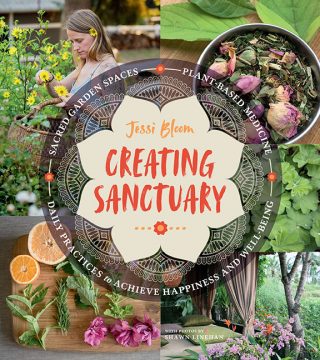Creating Sanctuary
Posted in From the Library on March 15 2019, by Esther Jackson
Esther Jackson is the Public Services Librarian at NYBG’s LuEsther T. Mertz Library where she manages Reference and Circulation services and oversees the Plant Information Office. She spends much of her time assisting researchers, providing instruction related to library resources, and collaborating with NYBG staff on various projects related to Garden initiatives and events.
 Creating Sanctuary: Sacred Garden Spaces, Plant-Based Medicine, and Daily Practices to Achieve Happiness and Well-Being by Jessi Bloom, with photographs by Shawn Linehan, is a well-designed book meant to teach readers the ways of self-care through the growing and use of plants. Bloom, the owner of N.W. Bloom EcoLogical Services, is based in the Pacific Northwest. She is an author and a landscape designer focusing on permaculture and sustainable landscape and garden design solutions.
Creating Sanctuary: Sacred Garden Spaces, Plant-Based Medicine, and Daily Practices to Achieve Happiness and Well-Being by Jessi Bloom, with photographs by Shawn Linehan, is a well-designed book meant to teach readers the ways of self-care through the growing and use of plants. Bloom, the owner of N.W. Bloom EcoLogical Services, is based in the Pacific Northwest. She is an author and a landscape designer focusing on permaculture and sustainable landscape and garden design solutions.
First, the good. There is no doubt that this book is beautiful. For readers wondering how to incorporate more plants into their lives, or even readers looking for ideas for Instagrammable tableaus, the book is worth a look. Book sections include Creating Sacred Spaces, Botanical Alchemy, and Nurturing Self: Healthy Body, Mind, and Soul.
Now, the not so good. Bloom manages to suggest at least three naturalizing-to-invasive species in her plant lists—Nandina domestica, Leonurus cardiac, and Artemisia vulgaris. Readers looking to Bloom for plant suggestions would do well to take her recommendations with a grain of salt and some research of their own. On the topic of foraging, Bloom does caution readers not to collect on public lands, but doesn’t really address the effect that hobby foragers can have on populations of native plants.
Finally, Bloom, not a medical doctor nor ethnobotanist, also writes extensively about the medicinal qualities of certain plants. This is not atypical for this type of book, but something for readers to take with caution. Thankfully, Bloom’s recipes are relatively simple and use edible plants known to be safe.
All in all, for readers interested in creating sacred spaces and adding more plants into their lives and routines, Bloom’s book is well-conceived and appealing. However, do not look to this work for an understanding of native species nor for medical advice.

